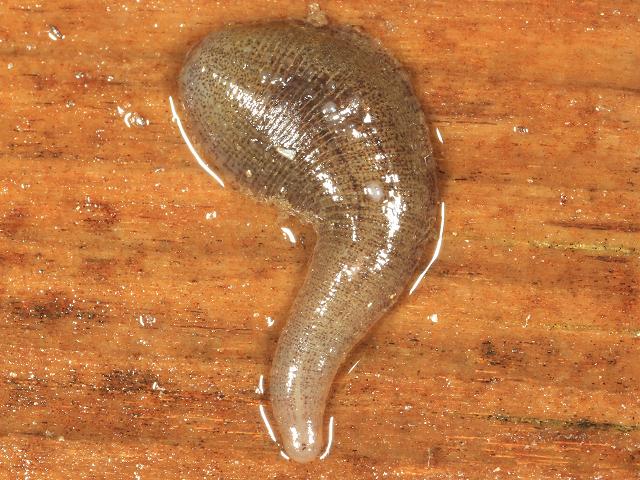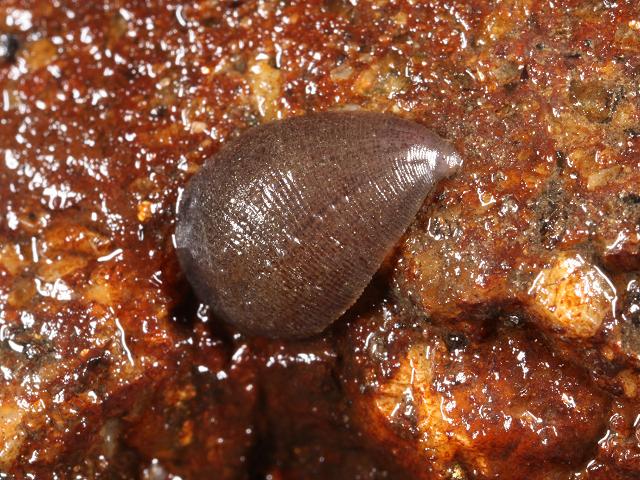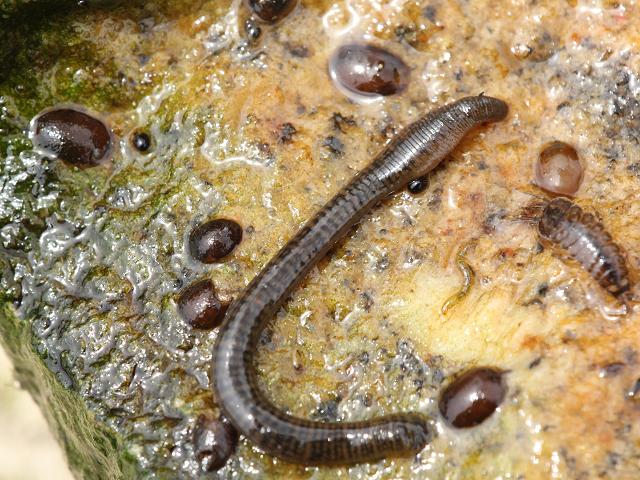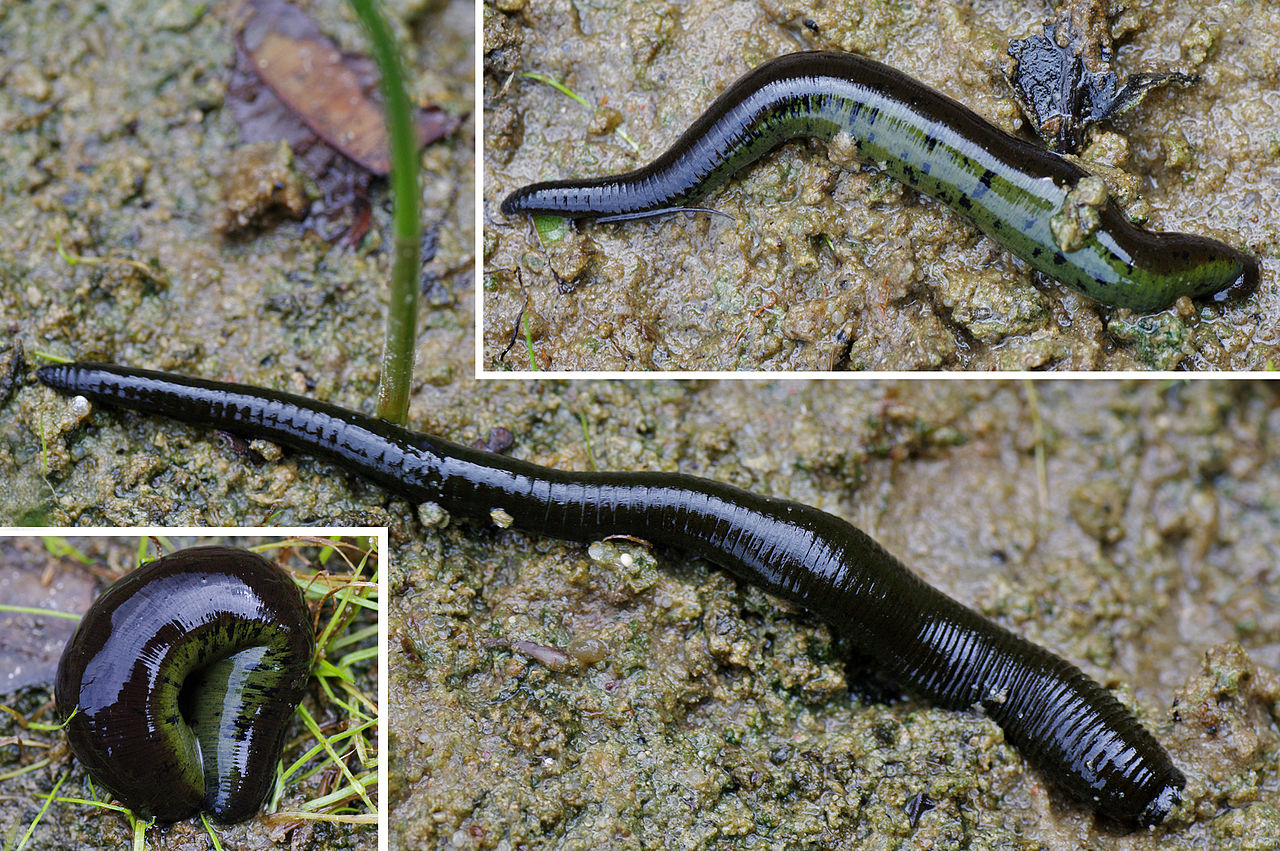- Home
- Garden Wildlife
- Annelids
- Leeches
Leeches
Leeches are annelid worms belonging to the small subclass Hirudinea, with about 680 species globally, mostly in freshwater. They are closely related to earthworms but have a very different appearance and way of moving. Leeches have flattened bodies with a small sucker on the underside of the head and a larger one at the rear end of the body. Their bodies have 33 segments but this is not visible externally, and they lack the distinctive bands that show obvious segmentation in earthworms.
Species in Britain and Ireland
There are 37 species of leeches in the British Isles and some commonly occur in ponds. Leeches are infamous for sucking blood from people and other mammals, but thse are rare in Britain and Ireland and very unlikely to be found in gardens. Some common leeches such as Piscicola geometra and Hemiclepsis marginata are parasites that suck blood from amphibians and/or fish. Piscicola geometra is up to 80mm long, slender with a cylindrical body section, and large anterior and posterior suckers. It spends much of its time rigidly extended, resting like a rod with its rear sucker attached to a plant. They swim strongly in a whip-like motion when they detect a fish, to which they attach, and pierce the skin with their mouthparts, and ingesting blood.
Predatory leeches
Although globally most leeches are blood parasites,most of those in Britain and Ireland are predators, feeding on tadpoles, insects and pond snails. We have three species of Glossisiphonia of which G. complanata is probably most common. It is up to 30mm long and feeds on snails. Erpobdella octoculata is a common species which swallows small living prey such as larvae of the fly Chironomus whole, but will also suck body fluids from wounded larvae and all manner of dead and decaying freshwater organisms, so is a scavenger too.
The largest pond species is the horse leech Haemopis sanguisuga which can be as long as 150mm when extended. It doesn't attack horses (or people) but feeds as a predator on other annelids, insects molluscs, tadpoles and small fish. It sometimes crawls out of the pond to capture earthworms.

Fish leech Leech Piscicola geometra feeding on the flank of a trout, with distinctive suckers at each end.
Biology
Leeches have contractile bodies, so are much longer when feeding or moving than when at rest. Some species can swim or they crawl by extending the head end and then bringing up the rear end, so they move in a looping fashion, reminiscent of a geometrid caterpillar.
Life cycle
LIke earthworms, Leeches are hermaphrodite animals that pair up in order to exchange semen. Most leeches deposit their eggs in egg sacs that are attached to plant stems, the underside of lily leaves or on the side walls of a pond. Goniophonia species and Hemiclepsis marginata retain their eggs in a pouch on the underside of the body. Newly hatched leeches are small versions of the adult animal. They become adult within a year.
Role of leeches in gardens
Fish parasites, such as Piscicola geometra, can have an adverse effect on fish if they are numerous. The predatory species are a natural part of a pond ecosystem and are despite their dodgy reputation, not a problem.
Website
None found!
Books and papers
Elliott, J.M. & Mann, K.H. (1998) A key to the British freshwater leeches. Freshwater Biological Association
Elliott, J.M and Tullett, P.A. (1982) Provisional atlas of the freshwaterleeches of the British Isles
Freshwater Biological Association Occasional Publication No. 14 cached here.
Kutchera, U. (2003) The Feeding Strategies of the Leech Erpobdella octoculata (L.): A Laboratory Study. Internat. Rev. Hydrobiol. 88:94-101 available here.
Page drafted by Andrew Halstead, reviewed by Andrew Salisbury, extended and compiled by Steve Head


Erpobdella octoculata with egg cocoons it is guarding Three views of the horse leech Haemopis sanguisuga


Two views of the leech Glossisiphonia complanata, extended and contracted.
Leeches
Leeches are annelid worms belonging to the small subclass Hirudinea, with about 680 species globally, mostly in freshwater. They are closely related to earthworms but have a very different appearance and way of moving. Leeches have flattened bodies with a small sucker on the underside of the head and a larger one at the rear end of the body. Their bodies have 33 segments but this is not visible externally, and they lack the distinctive bands that show obvious segmentation in earthworms.
Species in Britain and Ireland
There are 37 species of leeches in the British Isles and some commonly occur in ponds. Leeches are infamous for sucking blood from people and other mammals, but thse are rare in Britain and Ireland and very unlikely to be found in gardens. Some common leeches such as Piscicola geometra and Hemiclepsis marginata are parasites that suck blood from amphibians and/or fish. Piscicola geometra is up to 80mm long, slender with a cylindrical body section, and large anterior and posterior suckers. It spends much of its time rigidly extended, resting like a rod with its rear sucker attached to a plant. They swim strongly in a whip-like motion when they detect a fish, to which they attach, and pierce the skin with their mouthparts, and ingesting blood.

Fish leech Leech Piscicola geometra feeding on the flank of a trout, with distinctive suckers at each end.
Predatory leeches
Although globally most leeches are blood parasites,most of those in Britain and Ireland are predators, feeding on tadpoles, insects and pond snails. We have three species of Glossisiphonia of which G. complanata is probably most common. It is up to 30mm long and feeds on snails. Erpobdella octoculata is a common species which swallows small living prey such as larvae of the fly Chironomus whole, but will also suck body fluids from wounded larvae and all manner of dead and decaying freshwater organisms, so is a scavenger too.
The largest pond species is the horse leech Haemopis sanguisuga which can be as long as 150mm when extended. It doesn't attack horses (or people) but feeds as a predator on other annelids, insects molluscs, tadpoles and small fish. It sometimes crawls out of the pond to capture earthworms.




Two views of the leech Glossisiphonia complanata, extended and contracted.
Left: Erpobdella octoculata with egg cocoons it is guarding Right: Three views of the horse leech Haemopis sanguisuga
Biology
Leeches have contractile bodies, so are much longer when feeding or moving than when at rest. Some species can swim or they crawl by extending the head end and then bringing up the rear end, so they move in a looping fashion, reminiscent of a geometrid caterpillar.
Life cycle
LIke earthworms, Leeches are hermaphrodite animals that pair up in order to exchange semen. Most leeches deposit their eggs in egg sacs that are attached to plant stems, the underside of lily leaves or on the side walls of a pond. Goniophonia species and Hemiclepsis marginata retain their eggs in a pouch on the underside of the body. Newly hatched leeches are small versions of the adult animal. They become adult within a year.
Role of leeches in gardens
Fish parasites, such as Piscicola geometra, can have an adverse effect on fish if they are numerous. The predatory species are a natural part of a pond ecosystem and are despite their dodgy reputation, not a problem.
Website
None found!
Books and papers
Elliott, J.M. & Mann, K.H. (1998) A key to the British freshwater leeches. Freshwater Biological Association
Elliott, J.M and Tullett, P.A. (1982) Provisional atlas of the freshwaterleeches of the British Isles
Kutchera, U. (2003) The Feeding Strategies of the Leech Erpobdella octoculata (L.): A Laboratory Study. Internat. Rev. Hydrobiol. 88:94-101 available here.
Page drafted by Andrew Halstead, reviewed by Andrew Salisbury, extended and compiled by Steve Head












